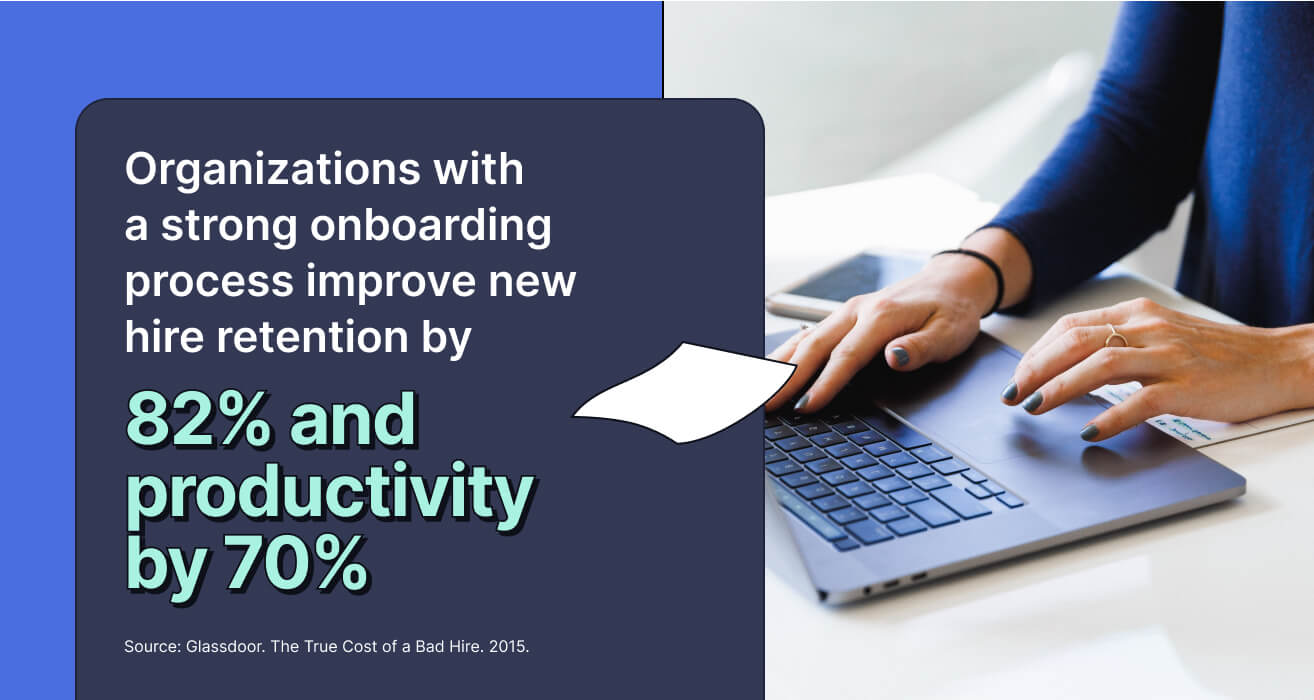Starting a new job has always been exciting, and for some people, excitement can also be stressful. Now, hybrid and fully remote work models have added more complexity to the crucial process of onboarding new hires. Without face-to-face socialization and casual hallway conversations, managers must be more proactive and thoughtful about reducing stress, forging connections, and accelerating success.
After all, when onboarding doesn’t go well, it can be costly. For example, one-third of new employees begin looking for a new job within six months, and 25% leave before they’ve been with a company for a year. That turnover comes with a hefty price tag: It takes 42 days to fill a position, and replacing someone can cost up to 60% of their annual salary.


The good news is that a positive onboarding experience can change a negative narrative into a success story. Organizations with a strong onboarding process improve new hire retention by 82% and productivity by over 70%. That said, building a successful onboarding program doesn’t happen overnight. There are concrete steps any organization can take to make meaningful improvements right away.
Here are seven of our favorite actionable tips to avoid the costs of haphazard onboarding:
1 Get a head start with “preboarding”
Before their first day in the office (in-person or virtual), you can begin “preboarding” new team members by setting up technology, scheduling meetings, and sharing relevant paperwork. Take time to build excitement with invitations to fun cultural events or sneak peeks into exciting work initiatives. It’s also the perfect time to add new employees to any recurring team meetings or company-wide events.
2 Keep onboarding information up to date
Information can change quickly, and sharing outdated materials with your new hire does not set them up for success. It can also damage trust. So. review your onboarding materials to ensure they’re current and relevant for your new employee’s role.
3 Build an open, connected culture of learning
Create an open culture for questions and build connections within the organization. Curate a shortlist of key teammates, how to contact them, and their areas of expertise. Focus the list on teammates with the most collaboration opportunities for your new hires.
4 Make day one about more than paperwork
No one feels inspired by hearing, “Here’s a pile of forms and manuals. Talk to you next week.” Yet, processes and paperwork make up the bulk of the first day for many companies. Mix it up by making day one a little more exciting:
- Many people learn by doing. See their unique strengths and find ways to boost their confidence by asking them to share feedback on the onboarding experience itself.
- Create connections early with lunches or happy hours—even over Zoom. Getting to know coworkers builds comfort and opens doors for questions and new ideas.
- Make a point to learn about newcomers’ previous experience with processes and software. This information can reveal gaps you may need to address with further training or drive innovation for your team.
One final note: Beware of acronyms. Once you’re in the club, acronyms become a code everyone speaks. But for newcomers, acronyms can be confusing or intimidating. Style guides can help build familiarity by showing expanded versions of common internal acronyms.
5 Start talking about goals and expectations right away
Make your new hire’s professional development a top priority. Start picturing the future together by setting clear expectations for immediate success. Create 30-60-90-day goals where supervisors and stakeholders drive some goals, while others are driven by the new hire’s interests and measures of success.
6 Plan beyond the first week
Many employers make the mistake of trying to teach new team members too much too soon. Rather, build an ecosystem of onboarding that helps them get acclimated over time.
One-on-one meetings are an excellent way to keep up with employees and ensure they have what they need. Empowering tools are another way to offer consistent support. Grammarly Business may ease some of the pressure new teammates feel and help them establish good habits early.
7 Reinvest in your existing team with “re-onboarding”
If you’re experiencing high turnover, you aren’t alone. Many companies are experiencing “The Great Resignation.” Your entire team could benefit from extra support as they navigate changing work environments and welcome a sea of fresh faces and ideas.
During times of change, established employees may feel like they are at a new company. Think about different cultural, operational, or strategic approaches from the last year or two. Then, create processes, including appropriate events, to help manage changes and bring the whole team up to speed.
Designing a positive onboarding experience is a worthy investment. Similarly, using Grammarly Business to ramp up your team, support consistency, and make work more efficient can reduce the likelihood of costly turnover while building a more cohesive, productive organization for the future.
If you’d like to learn more about how Grammarly Business can help improve your onboarding experience, contact us for a demo or get started today.




